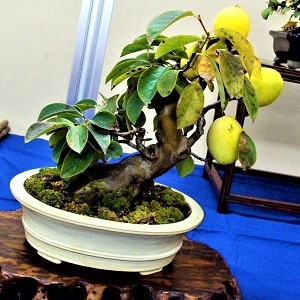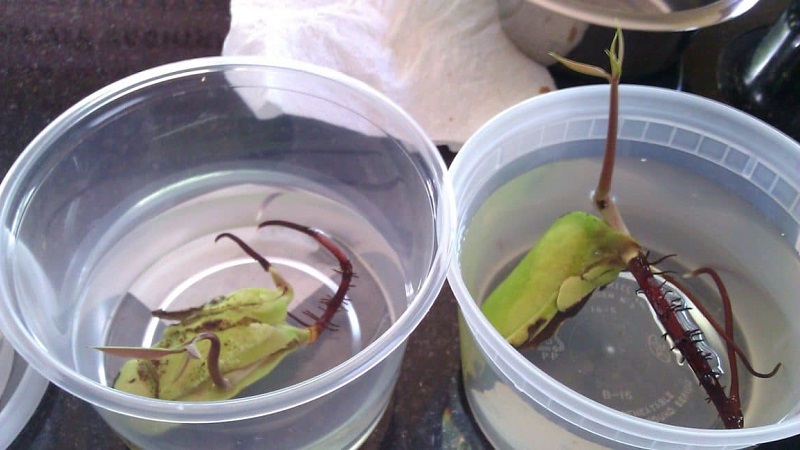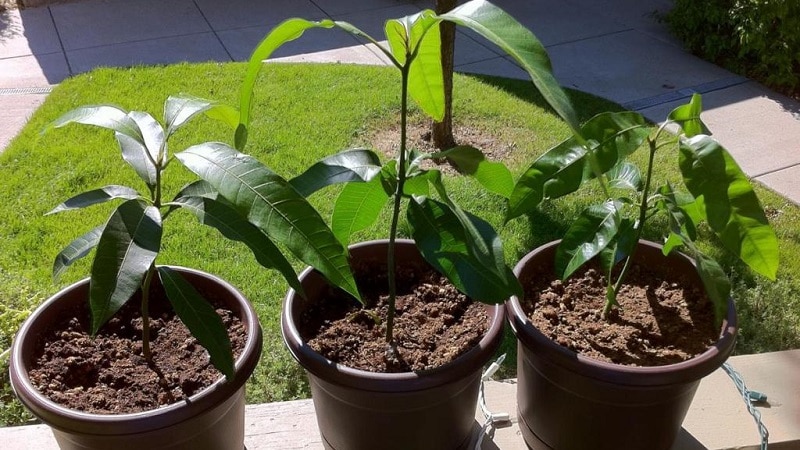How to grow mangoes from seeds at home
Mango is an exotic tree that grows in countries with hot tropical climates. It has large long leaves of bright green color, blooms beautifully and bears fruit abundantly in natural conditions. In our country, it is impossible to grow a mango tree in open ground - it will die at the first frost. But mango can become a houseplant that decorates the interior.
The easiest way to grow a tree is from a sprout, which can be purchased at a nursery. However, it is also possible to use a seed from a fruit purchased at the supermarket. If you follow the planting procedure correctly and provide proper care, a beautiful tree will grow in a pot in a few years. In most cases, the plant does not bear fruit at home, but some exotic lovers still manage to get a small harvest.
Is it possible to grow mangoes from seeds?
Mango often propagated generatively. In most cases, the seed actually germinates. This method of growing a mango tree has advantages.:
 Increased endurance. Plants grown by seed are always hardier than those propagated by branches. This method allows you to adapt the tree to the conditions in which it will grow, already at the beginning of its life.
Increased endurance. Plants grown by seed are always hardier than those propagated by branches. This method allows you to adapt the tree to the conditions in which it will grow, already at the beginning of its life.- Availability of planting material. Mango sprouts are expensive, you can only find them in specialized stores, and in small towns you will have to order them online. The fruit is sold in most supermarkets and costs less per fruit than a sprout.The mango can be eaten and the pit can be used for planting.
- Proper plant formation. When grown from a seed, the tree will turn out to be more neatly shaped.
- Strong roots. If with the vegetative method of propagation the shoot begins to gradually grow roots, then with the generative method the aboveground and underground parts develop evenly. The root system will be strong.
- Quality. A purchased ready-made sprout may be infected with viruses and fungi, treated with stimulants, or grown in unfavorable conditions. All these factors cause the death of mangoes and infection of other plants.
- Interesting process. Children and novice gardeners are often interested in the process of turning an ordinary seed into a full-fledged tree.
Many exotic lovers prefer to buy ready-made sprouts in nurseries. It's connected with disadvantages of seed propagation:
- Slow development. It will take a long time for the bone to turn into a tree. Cuttings become a full-fledged plant much faster.
- Large labor costs. The process of preparing and planting a seed, germinating planting material and growing a tree takes a lot of time, while the cutting quickly turns into a full-fledged plant.
- Necessity of vaccination. In 99% of cases, mangoes grown from seed do not bear fruit at home. To achieve fruiting, the plant will have to be grafted with a branch of a tree that has already produced a harvest. Sprouts from the nursery are usually already grafted.
- No guarantee of germination. Mango seeds have good germination capacity, but may not germinate. This is due to the immaturity of the fetus, improper storage, damage and some other factors.
Under natural conditions the tree reaches 10-50 m. The size of an indoor mango depends on the pot and the wishes of the owner, since at the desired level the growing point will have to be pinched. Typically, the size of a plant in an apartment does not exceed 2 m.
Interesting things on the site:
Growing figs from seed or sprout
Landing dates
Mango seed can be planted at any time of the year.. However, in winter and autumn the daylight hours are short, so additional lighting will be needed.
In spring and summer, it is not necessary to use additional lighting to germinate seeds, so it is better to carry out planting work during this period.
Note! Mango seeds should be planted immediately after they are removed from the fruit. The longer it sits and dries, the lower the germination rate.
Mango seeds do not need stratification, because in the natural growing conditions of the tree there are no cold winters.

Selection and preparation of seeds
In order to germinate a mango seed, it is important to choose the right fruit. It must be fully ripe, but not spoiled. When choosing, pay attention to the following parameters:
- Appearance of the peel. It should be smooth and shiny; a wrinkled surface indicates the unripeness of the fruit. You shouldn’t pay much attention to the shade; the color depends on the variety of mango; some varieties can be ripe even with green peel. It is important that the fruit is free of mold, rot, holes, suspicious spots and growths. These signs indicate that the plant was damaged during fruiting by diseases and pests that could reach the seed. Small dark specks are not a sign of infection, but evidence of maturity.
- Softness and elasticity. Ripe fruit should be easily pressed.A slight pressure quickly smoothes out the dent.
- Smell. A ripe fruit emits a characteristic pleasant aroma even when uncut. Green mango has almost no smell. Overripe fruit has an alcoholic odor.
If you were unable to purchase ripe mangoes, you can ripen the fruit Houses. It should be placed in a paper bag and placed near apples or bananas. In 2 days it will ripen.
Advice! Suitable for planting are the seeds of overripe, but not rotten, mangoes, the pulp of which is crushed but does not return to its previous shape. This fruit has an unpleasant taste.
The mango seed looks like a clam. It is taken out, washed, and the remaining pulp is removed.
If possible, you should crack the shell without touching the kernel.. The core is removed from the shell. If several sprouts are found inside, choose the strongest one. The rest can also be planted.
The core is soaked in light pink solution of potassium permanganate for 15 minutes. Fungicides or biologicals can also be used. This will protect the plant from infection by fungal diseases in the future.
If the shell does not give in, the seed is placed in a transparent container, filled with water at room temperature, placed in a warm place and wait for the valves to open and a sprout to appear. The water needs to be changed every 2 days.
Note! Often a seed that has already sprouted is found in the shell. Such planting material is not soaked, but is immediately planted in the ground.

How to plant a mango seed in a pot
Before you grow mangoes from seeds at home, you need to prepare the container and soil.. The success of the process depends on their quality.
The container for planting the seed should not be too large. The best option is a deep pot with a diameter of 10 cm.Containers that are too deep will lead to rotting of the roots, while containers that are too shallow will inhibit the development of the root system.
It is best to choose clay and ceramic options. They allow air to pass through, are able to absorb excess moisture from the soil into the walls, and then release it, preventing waterlogging and drying out of the soil. Plastic containers do not have such advantages.
Important! You should not plant several seeds in one container or select temporary plastic glasses. The plant will grow in the selected container throughout the first year, since young mangoes do not tolerate transplantation well.
Containers require mandatory disinfection. Ceramic and clay containers can be sterilized, like jars, or filled with boiling water. Often the container is soaked in a dark pink solution of potassium permanganate or a product prepared from 3 liters of water and 1 tbsp. l. copper sulfate.
Mangoes are often grown in universal purchased soil.. It is better to prepare the soil mixture yourself. To do this, you need to take 2 parts of soil with neutral acidity or lowland peat and mix with 1 part of river sand.
Important! Be sure to use drainage: expanded clay, broken brick, crushed ceramics, small crushed stone, shell rock, pieces of foam plastic.
Drainage and soil are disinfected: calcined in the oven, poured with a dark pink solution of potassium permanganate, boiling water or a solution of copper sulfate.
Step-by-step instruction
Planting a mango seed is easy. The main thing is to follow step by step instructions:
- Fill with drainage the container is about a quarter high. The rest of the volume is covered with soil so that 3 cm to the edge of the pot remains free.
- They dig in the center a small hole. The bone is placed in it with the root down.The hole is covered with soil so that the tip of the seed sticks out from under the ground.
- The soil is moistened water at room temperature.
- Build a greenhouse: a part of a cut bottle, bag or film is put on the pot.
- The bone should remain under the greenhouse until the sprout emerges from the ground. This takes about a month.
Before germination, the seed is watered once every 3-4 days.. It is important that the soil does not dry out, but also does not become waterlogged. Every day the greenhouse is opened slightly for 10-15 minutes. This will help prevent mold from forming.
After the sprout appears, the greenhouse begins to be opened slightly every day.. First for 15 minutes, then for 30. Gradually, the duration of ventilation is increased to a day. After this, the film is removed.
Advice! If the plant is covered with film, hardening can be done differently. After the shoots emerge, several holes are made in the film. Gradually their number and diameter are increased, then the greenhouse is dismantled.
Possible mistakes
When planting mangoes, it is important to avoid a number of mistakes. The list shows the most common of them:
- Planting too deep. If you cover the seed with a thick layer of soil, it will take a long time to germinate. There is a possibility that the sprout will not appear at all, because the seed will rot in the ground. If the planting material is not buried deep enough, it will not have enough moisture, which will lead to its death.
- Germination without a greenhouse. During germination, the plant needs to create tropical conditions in which there is high humidity, reduce temperature changes, and protect from drafts. These parameters can be achieved by covering the plantings with film, glass or plastic. If this is not done, the chances of germination will be reduced.
- Watering with cold water. In this case, the development of the sprout stops, and the seed begins to rot. If you water an already emerging sprout with ice water, the likelihood of infection with blackleg increases.
- Using unsuitable containers. Mango has long roots. If there is not enough space, the plant will not be able to develop a full-fledged root system, it will begin to hurt and die. If you use a container that is too deep, the tree will develop only the root system, the above-ground part will be weak and stunted.
- Long-term storage of bones before boarding. The earlier you plant a mango seed, the higher its germination rate will be. Planting material stored for several months has a low chance of germination.
Mango care at home
The mango will grow quickly, because under natural conditions it can stretch more than 1 m in a year. In order for the plant to develop correctly, it is important to provide it with care.:
- Temperature. Mangoes do well at room temperature. In winter there is no need to take it out into a cool room. In summer, a pot with an exotic plant can be placed outside.
- Humidity. Optimal humidity is 70-80%. When the air is dry, the tree begins to ache, wither, and become infected with pests. In winter, when the heating is on, humidifiers are used.
- Lighting. The light-loving mango tree is grown on a southern or western windowsill. In winter, whenever possible, use fluorescent lamps as an additional light source.
- Watering. Mangoes are watered every other day in the warm season. During the cool season, when the soil dries more slowly, 1-2 waterings per week are sufficient. Use water at room temperature. The procedure is carried out in the morning or evening, when the sun is inactive.
- Spraying. Plants are moistened 2-3 times a week with water at room temperature. There is no need to spray the leaves more often, as this will increase the risk of infection with fungal infections, to which mango has low resistance. Once a week, it is recommended to wipe the leaves with a damp cloth to remove dust.
- Feeding. Mangoes are fed 2 times a month, alternating organic and mineral substances. Many exotic lovers use complex fertilizers for citrus fruits.
- Formation. When the height of the tree reaches 1 m, its top is pinched. Next they begin to form the crown. It is optimal to leave no more than 3-4 branches directed in different directions in each order.
- Trimming. Sanitary pruning is carried out once a year. Remove all dry and damaged branches, shoots growing inside the crown, twisted and deformed shoots.
- Prevention. Once a year, the tree is sprayed with a light pink solution of potassium permanganate or copper sulfate. This is especially true if mangoes are put outside in the summer. This procedure will prevent fungal infections.
- Loosening. After each watering, the soil is loosened to destroy the earthen crust, which prevents normal air circulation. It is convenient to use a fork for these purposes.
- Transplants. The tree is replanted once a year. The plant is pulled out of the pot and placed in a new container along with a lump of earth. A new layer of drainage is poured into the bottom of the pot.

How to graft a twig grown from a seed
In most cases, mango grown from seed does not produce a harvest at home. Reviews say what to achieve Fruiting can be achieved by grafting.
The procedure is best done in the second year of cultivation. By this time, the plant trunk should correspond to the diameter of a pencil.
The rootstock is taken from a healthy mango tree that is already bearing fruit.. It corresponds to the diameter of the scion. The branch is cut at an angle of 45°; at least 3 living buds should remain on it. Instead of a cutting, you can use a bud.
The vaccination is carried out in the middle of summer, following the following instructions:
- The mango is cut to 2/3 of its length. There should be no leaves or buds left on the rootstock.
- A 3-4 cm long split is made in the center of the rootstock. The rootstock split should be slightly deeper than the length of the scion wedge.
- All leaves are removed from the scion. It is sharpened with a flat wedge 3-4 cm long.
- The scion wedge is inserted into the split of the rootstock. The joints are wrapped with garden tape or electrical tape.
- The cut areas are covered with garden varnish.
When the shoot takes root, the tape is removed. The fact that the rootstock has taken root will be indicated by the swelling of the buds, the appearance of leaves and sprouts.
Usually the first flowering occurs 2-4 years after grafting. After 3 months you will be able to taste the fruits.
Advice from experienced gardeners
A few tricks to make growing mangoes easier:
- Instead of special fertilizers for mangoes, you can use a weak solution of mullein or an infusion of herbs. Any weed is suitable for preparing herbal infusion.
- Instead of watering the plant's soil, experienced gardeners pour water into a tray under the pot. From there, the tree will absorb the amount of liquid it needs. Add water as needed.
- In order for the plant to develop evenly, it is rotated relative to the window 2 times a week. Otherwise, it will stretch towards the sun and bend.
Conclusion
It is quite possible to grow a mango from a seed. In most cases, the seed removed from the fruit germinates.Such a tree will not bear fruit, but this can be corrected by grafting.
In Russia, a mango tree will not survive in open ground. It can be grown as a houseplant. The main thing is to provide optimal conditions and proper care.
Good afternoon. If two shoots come from the seed, what should you do (leave it or is it better to cut one)?